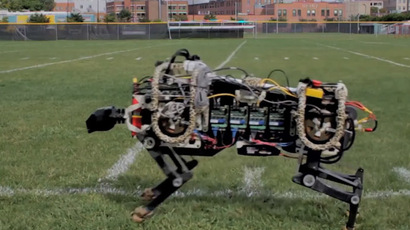‘Octorobot’ can swim in ocean, carry objects (VIDEO)

Not content with developing artificial crabs and jellyfish, scientists have now welcomed another sea creature to the world of aquatic robots: the octopus.
The ‘octorobot’ doesn’t have a name just yet, but a team of Greek researchers headed by Dimitris Tsakiris has managed to do something even more impressive than design a machine that looks at home in the water.
Not only can this robot swim, but its speed has almost doubled since the first time it was unveiled in 2013.
Shown off at the IEE International Conference on Intelligent Robots and Systems, the robotic octopus now sports partially-webbed arms and a smaller head. While it previously swam at about four inches a second, the new silicon webbing now allows it to swim seven inches per second.
“The eight-arm robot is inspired by the morphology and outstanding locomotor capabilities of the octopus,” researchers from the Foundation for Research and Technology-Hellas wrote in a paper on their invention, as quoted by the Daily Mail.
“Underwater experiments demonstrate a novel mode of underwater propulsion by combining various patterns of sculling movements of the arms and web, and the efficiency of the swimmer, especially with the addition of the web, in terms of the attained velocities, the generated propulsive forces and the cost of transport,” the paper said.
In a video posted on YouTube, viewers can see for themselves just how improved the robot’s mobility is. Researchers also filmed the ‘octopus’ crawling on the floor of an aquarium and carrying a yellow ball while swimming, before concluding with footage of the robot freely moving in the Aegean Sea.
If the robot ever becomes operational for practical purposes, scientists are hoping to use it to observe ocean animals without disturbing them.













